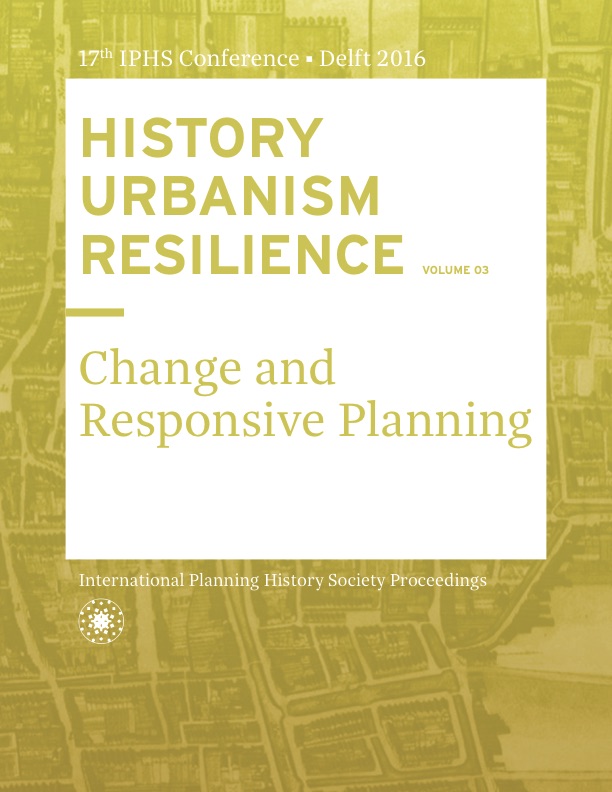TOWARDS RESILIENCE IN CHENNAI
DOI:
https://doi.org/10.7480/iphs.2016.3.1266Abstract
Global mean temperatures have increased, average sea levels have risen, snow cover has decreased, glaciers and icecaps have started to melt, thunderstorms and torrential rains have occurred in dry areas, all pointing towards climate change. NASA has mentioned that majority of the climate scientists agree that these indicators of climate-warming trends over the past century are mostly due to human activities. The United Nations has endorsed this position and forecasted that around 50 million people will become environmental refugees by the end of this decade (UNEP, 2005). Due to this, most of the world is debating how to reduce greenhouse emissions that cause climate change and how to build resilience to the inevitable effects of climate change through various climate summits. Even though the awareness of building resilience in cities exists around the world, developing nations are facing challenges in building resilient cities due to over population and unplanned growth in the process of rapid urbanisation and economic development.One such example is Chennai, a coastal city in India. Though the city has experienced major floods in 1943, 1978, and 2005; the recent unprecedented rainfall in the fall of 2015 caused by the El Nino phenomenon had collapsed Chennai with flash floods. This presented an Indian context of climate change crisis – which is a consequence of expanding cities over existing environmental systems thereby damaging them severely. The city of Chennai, from Pre Independence to Post Independence, has been filling natural ponds, lakes and marshes to expand the city to allow closer proximity to the city centre for economic development. While these actions have resulted in increased flooding during rain, conditions of water scarcity has been observed during summer.
Hasty urbanization has given no regard to the traditional system of planning which had once respected nature and combated floods and droughts through the various cultural practices and taboos practiced by the people. Thus, it is essential to look back at the planning trajectory of Chennai and to recognise methods used traditionally in the region to survive the environmental disaster, making the city flood resilient. This research explores the possibilities of alternative and sustainable approaches for resilient urban development using the environmental disaster of Chennai’s 2015 flood as a case study. This examination uncovers the traditional, the British Raj-era, the post-Independence, and the contemporary development context in order to understand the local context for where and when coastal human settlement negatively impacted the natural system.
As Eliot Scalar said, “adaptation is the key. If we need to reverse climate change, we first have to survive long enough to do that”- Century of the city- No time to loose (Rockefeller Foundation, 2008).
References
Centre for Science and Environment. “CSE PRESS NOTE: Chennai in crisis.”cseindia.org. http://www.cseindia.org/content/cse-press-note-chennai-crisis (accessed May 29, 2016)
CDMA .2007. Master Plan - II for Chennai Metropolitan Area - 2026, March 2007, Chennai Metropolitan Development Authority, Tamil Nadu.
Folke, C .2006. “Resilience: The emergence of a perspective for social-ecological systems analyses”.Global Environmental Change 16: 253–267
G K Rao “who let water into my city”series.fountainink.in.
http://series.fountainink.in/who-let-the-water-into-my-city (accessed May 29.2016)
Governance Screening for Urban Climate Change Resilience-Building and Adaptation Strategies in Asia : Assessment of Chennai City , India August 2007. 2007, no. August.
Gupta, Anil K, and Sreeja S Nair. 2010. “Flood Risk and Context of Land-Uses : Chennai City Case” 3 (December): 365–72.
Horrison, ArEbin, and Ar Lilly Rose. 2008. “URBAN CLIMATE MAPPING FOR SUPPORTING URBAN PLANNING IN CHENNAI , INDIA,” no. Cmda: 0–5.
Introduction, A, B Current Scenario, In Chennai, and Metrospolitan Area. n.d. “Disaster Management,” 99–102.
Lavanya, Ar K. 2012. “Urban Flood Management – A Case Study Of Chennai City Abstract :”
Neal R. Peirce and Curtis W Johnson, Century of the City: No Time to Lose, 2008 (Rockfeller Foundation, 2008)
Nelson, Donald R.; Adger, W. Neil; Brown, Katrina (2007). “Adaptation to Environmental Change: Contributions of a Resilience Framework” (PDF).Annual Review of Environment and Resources 32: 395–419.
Planners, Town. 2011. “An Analysis of Growth Dynamics in Chennai Metropolitan Area,” no. December: 31–57.
Rao Sahib C.S Srinivasachari. “History of the city of Madras”. Tercentinary Celebration committee (1939)
Shekhar, Satyarupa, and Madonna Thomas. 2015. “Chennai ’ S Rain Check Fifteen Years and Counting,” 1995–97.
Srinivasachari, C. S. 1939. “Introduction”. History of the city of Madras written for the Tercentenary Celebration Committee. Madras: P. Varadachary & Co.
Swamidurai, Santhakumar. 2014. “Factors Affecting Urban Land Value in Indian Cities - Chennai City as a Case Study” I (Iii): 31–34.

